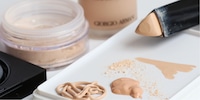
Guide
Cushion, stick and everything in between: which foundation is right for you?
by Natalie Hemengül

First skincare, then make-up. But the two don’t always mix well. The result? Separation. Read on to find out why this happens and what to do to prevent it.
Freshly applied make-up looks beautiful. The only enemy? Time. And sometimes your skincare. Because what you wear underneath is as important as what you wear on top. The ingredients of your foundation and skincare products should be compatible. If they aren’t, you will notice it after a short time because the make-up separates and looks blotchy.
But why?
According to Michelle Wong, who has a PhD in chemistry and is a science blogger, foundation is primarily a mixture of two ingredients – water and oil, for example – that is combined by adding an emulsifier (an additive). If you look at the mixture under a microscope, you will see that small drops of one liquid are surrounded by the other liquid. In other words: the small droplets, also called the inner phase, float in the other liquid, the outer phase, thanks to an emulsifier. This is where the pigments of a foundation are. Applying this knowledge to the example of oil and water means that tiny droplets of oil disperse in the water and don’t separate from it. The oil is the inner phase, the water the outer phase.
There are numerous foundations, each relies on a different mixture, such as water-in-oil, oil-in-water or – what most manufacturers work with – water-in-silicone. Your foundation works best with a primer or cream that has the same outer phase, also called a base. This way they blend well. So with a water-in-silicone foundation, the outer phase of your skincare should be silicone. If the external phases differ, the products repel each other.
If you apply a silicone-based foundation over a water-based cream, the complexion can quickly look blotchy because silicon doesn’t mix with water or oil. This incompatibility causes pigments to accumulate in certain places on your skin, resulting in clumps.
Quite complicated, I know.
If you know the external phases of your products, it’s easy to judge whether they’re compatible or not. The problem is that brands don’t declare on their products which external phase they used in the production. That would be too easy. However, Wong says there are clues to help you figure this out.
Ingredients:
the order in which the ingredients of a product are listed depends on the proportionate amount of each ingredient contained. So if there is more water in your foundation than other ingredients, water will be listed first and so on. However, just because water is at the top of the list, it doesn’t automatically represent the base or outer phase of a product. That would be a wrong conclusion.

Let me give you an example: if the outer phase of a foundation is silicone and the inner phase is water, this doesn’t automatically mean the mixture contains more silicone than water. It may well contain more water than silicone. And as a result, the ingredient water is listed ahead of silicone in the list of all ingredients, even though the product is silicone-based. So the order of ingredients doesn’t tell you which external phase you’re dealing with.
According to Michelle Wong, however, the list can still be worth a look. According to the expert, nowadays almost all liquid foundations are made from a water-in-silicone mixture. If a silicone is represented in one of the first four places on the ingredients list, rest assured that silicone is the base of your foundation. Check here to find out which word endings you can recognise silicon by.
Texture:
but what if there is no silicon listed on the product? In this case, Wong recommends taking a close look at the texture. It provides information about the composition of your foundation: for example, water-based foundations tend to be more fluid, while thick, creamy foundations as well as sticks are most likely to be oil-based. Analyse the texture of your skincare this way: water-based skincare products tend to be absorbed more quickly and are thin, while oil-based products are richer and thicker. Also, creams that are oil or silicone-based tend to feel greasy. If in doubt, check whether the skincare can be washed off with water or not. If this doesn’t work, the outer phase is most likely oil or silicone.
These tips are only guidelines. Depending on the formula and number of individual ingredients, products with different bases can also work together harmoniously. Studying is good, trial and error is better. Preferably with free samples or testers.
As a massive Disney fan, I see the world through rose-tinted glasses. I worship series from the 90s and consider mermaids a religion. When I’m not dancing in glitter rain, I’m either hanging out at pyjama parties or sitting at my make-up table. P.S. I love you, bacon, garlic and onions.
Practical solutions for everyday problems with technology, household hacks and much more.
Show all